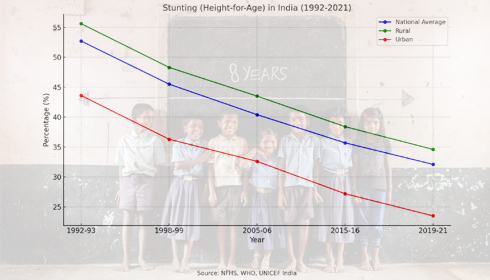
World Bank Report Indicates Challenges for India’s Fight against Child Malnutrition and Stunting
Despite years of legislative initiatives, India's problem with child malnutrition and stunting continues to be a major public health concern. The latest World Bank report, "Poverty, Prosperity, and Planet: Pathways Out of the Polycrisis," provides a bleak image of the country's progress in combating hunger, poverty, and child stunting. Despite the progress, India's long-term development objectives face significant challenges due to the insufficient rate of change to meet national and global ambitions.
Malnutrition rates in India have fallen in recent years, but the World Bank's studies show that the pace of decline is too sluggish. Despite years of efforts by organisations such as Integrated Child Development Services (ICDS) and Poshan Abhiyaan, malnutrition remains a common issue. Research indicates that chronic malnutrition significantly impacts the development of 35.5% of Indian children under the age of five. This ratio is down from 38.4% in 2016, yet progress is far from sufficient to meet the Sustainable Development Goal (SDG) of eliminating all kinds of malnutrition by 2030.
Furthermore, 19.3% of Indian children suffer from wasting, a condition characterised by low weight relative to height, a sign of severe malnutrition. According to World Bank data, while government measures have been helpful, factors such as poverty, inadequate healthcare, and food insecurity continue to worsen the issue, particularly in rural areas and among marginalised people.
The World Bank's research compares the Indian government's claims of economic development with the reality for millions of its residents. Despite the country's ambitious objectives of becoming a $7 trillion economy By 2030, economic expansion has not resulted in significant improvements in children's nutrition and health outcomes. India's Global Hunger Index's (GHI) ranking is lower than that of its South Asian neighbours, Bangladesh and Nepal, indicating deeper systemic challenges in combating hunger and malnutrition. India ranks 107th out of 121 nations on the Global Hunger Index, indicating severe levels of hunger, undernutrition, and child mortality.
The report finds that, while India's poverty rates have decreased in recent years, the number of individuals living below the broader poverty line of $6.85 per day has climbed. With over 129 million Indians living in extreme poverty, the task of providing proper nourishment for children becomes much more difficult.
Poverty fuels food insecurity, which remains one of the leading causes of malnutrition in India. According to World Bank data, about 130 million Indians live on less than $2.15 per day, with many unable to purchase basic sustenance. Rising food prices, especially for staples like pulses, vegetables, and grains, have made it harder for households to provide adequate meals for their children, resulting in poor growth results.
The Public Distribution System (PDS) in India faces challenges in reaching remote and rural areas, despite its intention to ensure food availability for the poorest households. Furthermore, inequalities in healthcare access mean that many children do not receive the medical attention they require to avoid malnutrition-related disorders. The World Bank emphasises that without targeted social safety nets, India's aim to eliminate child stunting and malnutrition will remain unattainable.
India's enormous and rising population complicates the malnutrition situation. The need for food, healthcare, and jobs is rapidly rising, putting enormous strain on government resources. According to the research, while poverty reduction has been modest, population expansion has outpaced improvements in healthcare and nutrition. As a result, millions of children remain vulnerable to malnutrition, particularly in rural regions with limited infrastructure and services.
While India's population is expected to stabilise in the following decades, tackling the malnutrition epidemic would necessitate coordinated initiatives, such as improved resource allocation, healthcare services, and stronger governance.
The World Bank research serves as a sharp reminder that, while economic growth is crucial, it alone cannot eliminate malnutrition and child stunting. India must prioritise inclusive development, with an emphasis on policies that guarantee that all children have equitable access to healthcare, nutrition, and education. Experts believe that enhancing existing nutrition programmes, boosting social safety nets, and improving healthcare delivery in rural regions are essential initiatives India should take to accomplish its nutrition goals.
As the country grapples with increased poverty and food insecurity, combating child malnutrition and stunting will necessitate immediate, coordinated effort across several sectors. Without quick intervention, India risks failing to meet its worldwide commitments to eliminate malnutrition and enhance the health of future generations.